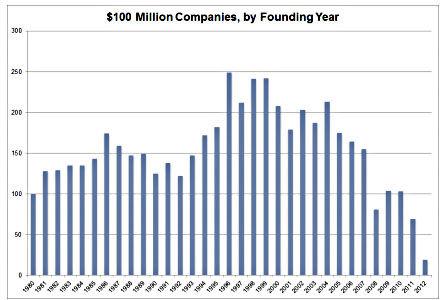Here’s a quick follow-up to my post last week about the decline in new business startups over the past few decades. Does this suggest that America is getting less entrepreneurial? In one way, yes: some of it is probably due to big national chains making it harder to start small family businesses, and some of it is probably due to an aging population. Economically, however, the triumph of gigantic chain stores isn’t necessarily a bad  thing, and the aging of the baby boomers should be thought of as a separate demographic issue, not a business startup issue.
thing, and the aging of the baby boomers should be thought of as a separate demographic issue, not a business startup issue.
Still, economists all agree that the key to a healthy economy is young, growing companies (not small businesses pe se). So how are we doing on that score? Over at Slate, Jordan Weissman points to a study by Paul Kedrosky that tries to quantify the number of startups that grow to $100 million or more in a fairly short period. The chart on the right shows his results. There’s a spike during the dotcom boom of the late 90s, and a dropoff during the Great Recession—a period too recent to have yet produced very many $100 million companies anyway—but there’s basically no secular decline at all. Roughly speaking, America has been producing about 150 small, fast-growing companies per year for the past three decades.
This is just a single data point, and Kedrosky warns that his data is necessarily pretty rough. But it does suggest that although America might be producing fewer new coffee shops and boutique clothing stores, it’s not necessarily losing its inventive edge.













